Ch 36: Resource Acquisition and Transport in Vascular Plants
1/89
There's no tags or description
Looks like no tags are added yet.
Name | Mastery | Learn | Test | Matching | Spaced |
|---|
No study sessions yet.
90 Terms
What resources do plants acquire?
Co2
H2O
Light
Sugar
Are there any trade-offs in resource acquisition?
What are the two major transport continuums in plants?
Apoplast and symplast
How are resources transported over short distances within the plant?
How are resources transported over long distances within the plant?
What are the main ways plants acquire resources?
Through leaves (above ground) and roots(below ground_
What is acquired through the shoots?
Sunlight and CO2
very rarely water through stomata
What is acquired through the roots?
water and dissolved minerals
Why is sunlight and CO2 needed?
for photosynthesis
Co2 + H2O + Sunlight → Sugar (Chemical Energy) + O2
What are the common minerals absorbed by the roots?
Nitrogen
Phosphorous
Potassium
Why are N, K, and P needed for plants?
for many cell functions like photosynthesis
They are important components of organic compound
proteins (made of nitrogen) and nucleic acids (made of nitrogen and phosphorous)
What is LAI?
stands for Leaf area index
represents the ratio of the total leaf area to the ground area beneath the plants
indicates how much leaf surface is available for photosynthesis and other processes.
What are the different stem length patterns?
Short stems
Long stems - to grow above others and avoid shading
What are the different branching patterns?
lots of branching - improves sunlight interception and increases LAI
small amnt of branching
What is the tradeoff for different stem and branching patterns?
plants have to choose between growing tall or having more branches
What different ways shoots can vary for resource acquisition?
stem length and branching pattern
Leaf size, arrangement, and orientation
Opening/closing of stomata
What are the different types of leaf size for resource acquisition?
large leaves - wet envrionments
Small leaves - dry environments
What is the tradeoff for larger leaves?
larger leaves require more water and lose more water than smaller leaves because of their greater surface area
What are the different ways leaves can be arranged on a stem?
Opposite or alternate
On one plane or more planes
Describe opposite vs alternate leaf arrangement?
Opposite: Two leaves per node, positioned directly across from each other.
Alternate: One leaf per node, positioned alternately along the stem.
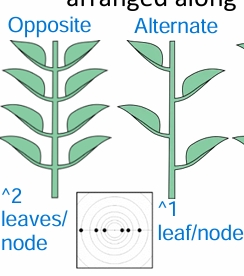
What are the different ways leaves can oriented?
vertical
horizontal
Describe leaf arrangement on one plane vs many?
One Plane: All leaves are in the same plane, either around a central point or along a straight line (common in rosettes or some opposite/alternate arrangements).
Many Planes: Leaves grow at different angles and positions, forming a spiral or helical pattern, creating a 3D arrangement that allows better light interception (common in pine trees, cacti, and ivy)
many = higher LAI
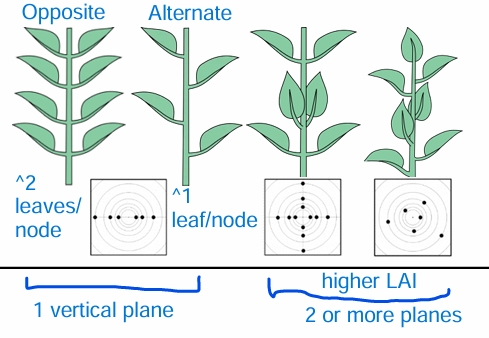
What are the benefits of vertical leaf orientation?
less exposed to the intense midday sun to reduce heat stress and water loss
where sunlight is limited, such as shaded or crowded areas, vertical leaves may help the plant maximize light capture by avoiding shading from other leaves.
less likely to catch wind to avoid damages
Prevents water from collecting on leaf which reduces fungal or mold growth
What are the benefits of horizontal leaf arrangement?
large surface area to capture sunlight
improved CO2 absorption
maximized water collection
provide protection for lower leaves
improved heat dissipation
adapted for crowded environments to capture light through gaps
In what ways can stomata’s be used for resource acquisition?
opening the stomata to take in more CO2
closing the stomata to stop loss of water
How much water is lost through the stomata?
95%
What is a tradeoff of water loss through the stomata?
Closed stomata means less water loss but also means less CO2 intake = lower photosynthesis levels
What parts of plants help to keep water in?
Leaves and stems that have waxy cuticles
How can stomatal density be affected by genetics and environments?
Plants adapt genetically to dry/wet environments by have less/more stomata
Low levels of CO2 during leaf development will increase stomata
How are stomata’s able to open and close?
guard cells
if swollen with water, they are turgid and bow out to open the stomata (accumulation of K+ in vacuoles)
K+ leaves guard cells, water follows, stomatas are shrunken and closed
What are the 3 primary cues for a stomata to open?
Light at dawn
Co2 Depletion in air spaces
internal circadian clock
Why would the stomata want to be open during the day?
to get more CO2 to come into the plant while the sun is out so photosynthesis can take place
When might the stomata close?
When too much water is being lost
Under water stress like a drought
closed stomata conserves water
In what ways can roots change to for optimized resource acquisition?
Root length/depth
branching pattern
hair density
When might root length/depth change?
to access deeper nutrients or water
if water levels lower, roots can grow to reach it
What are the benefits of different root branching patterns?
accessing water at varying depths
Branching into pockets with more nutrients
What are the benefits of different root hair density?
high density increases water and nutrient uptake
Low density = less uptake
In what ways are roots genetically controlled to be different?
monocots have fibrous roots that are more spread out horizontally to access water closer to the surface
eudicots have tap roots that grow deeper to access deeper water
What plants are known to have vertical leaf arrangment?
cacti and some grasses
What plants are known to have horizontal leaf arrangement?
sunflowers
cabbage
many grasses
What is apoplast?
a major transport continuum including everything external to living cell plasma membranes
includes cell wall, extracellular spaces, interiors of dead cells like tracheids and vessel elements (water collecting cells of xylem).
crosses through many cell membranes
What is symplast?
a major transport continuum
includes everything internal to cell plasma membranes like cell membrane and protoplasm
crosses one cell membrane and more to other cells through plasmoedsma
What is protoplasm?
a term used for the cell membrane and its contents
What is plasmodesma?
“doors/tunnels” that connect different cells
What is the transmembrane route?
it goes through both apoplast and symplast transport continuums
At what level does short distance transport occur?
the cellular level = moving substances into or out of the cell
How is short distance transport controlled?
through membrane permeability (passive or active)
What is passive transport?
no energy input from cell
substance moves along its concentration gradient
includes diffusion and osmosis
What is active transport?
needs energy(atp) from the cell
substance moves against its concentration gradient
includes pumps and transport proteins
What is diffusion?
net movement of particles from area of greater concentration to area of lesser concentration
What is osmosis?
the diffusion of “free” water molecules
What is water potential?
Symbol = Ψ (like trident)
It is the gradient for water movement in osmosis
How does water move along the water potential?
It moves from high to low potential to reach equillibirum
What is the formula for water potential?
Ψ= ΨS+ ΨP
What are the two components of water potential?
solute potential (ΨS)
pressure potential (ΨP)
What is the unit for water potential?
Mega Pascal (MPa)
What is the water potential of pure water?
0 MPa
What is a solute potential?
ΨS
component of water potential based on solute concentration
highest value it can be = 0
Adding solutes decreases ΨS and water will follow
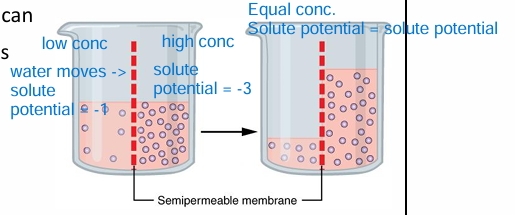
What is pressure potential?
ΨP
component of water potential based on physical pressure exerted on water within a system
Can be a positive or negative value
positive = turgid cells, water moving water from the pressure
negative = tension cells, water moving towards the pressue
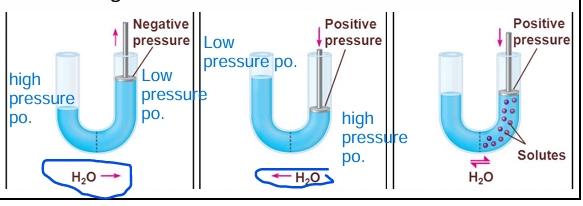
What does it mean for a plant cell to be turgid?
The cell is filled with water
lower solute potential inside the cell compared to surroundings
pressure potential is postive
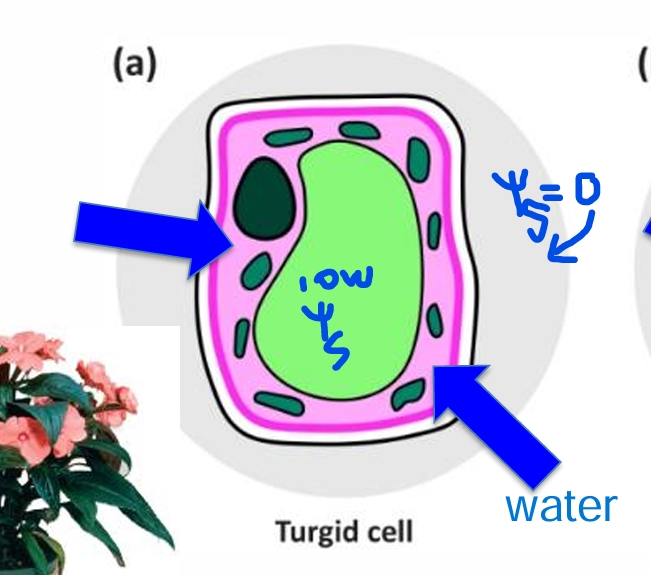
What does it mean for a plant cell to be flaccid?
Water is leaving the cell
the surroundings have lower solute potential
pressure potential is negative
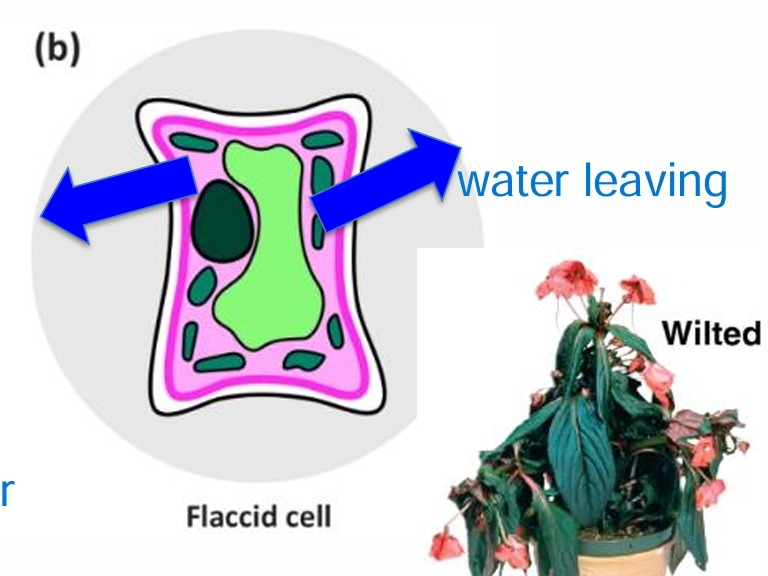
If isolated plant cells with a water potential averaging-0.5 MPa are placed into a solution with a water potential of-0.3 MPa which of the following would be the most likely outcome and why?
A. The pressure potential of the cells would increase
B. The cell walls would rupture, killing the cells
C. Water would move out of the cells
D. Solutes would move out of the cells
Because water moves from high water potential to low water potential, water would move into the cell because it has a more negative value than the solution
SO the pressure potential of the cells would increase and water potential would increase
If isolated plant cells with a water potential averaging-0.5 MPa are placed into a solution with a water potential of-0.3 MPa What would the water potential of the cell be at equilibrium?
Outside it would stay -0.3 MPa and the inside would also be -0.3 MPa to be equal
Outside = Inside
How do plants use proton pumps?
uses energy to pump H+ protons out of the cell to establish a membrane potential and proton gradient
Protons are now able to diffuse back into the cell, with solutes(moving against their gradient), through cotransporters
What type of pumps does plants use?
proton pumps
(unlike animals which use sodium-potassium pumps)
What are cotransporters?
A type of protein that H+ protons will use to get back into cell after a membrane potential and proton gradient are established
What is bulk flow?
type of active transport
The movement of a fluid driven by a pressure gradient
the fluid is pushed or pulled in a uniform direction
How are resources transported over long distances?
through active transport like proton pumps
Why can diffusion and osmosis not be used for long distance transport?
Because those pathways are too slow
What moves though cells of xylem and pholem?
water and solutes together
What do branching veins ensue in regards to cells?
ensure all cells are within a few cells of vascular tissue so they can receive water and nutrients
What routes are used to move water from soil to xylem?
apoplastic
symplastic
transmembrane
What is the process of moving water form soil to xylem? (5 steps)
Apoplastic route
symplastic route
transmembrane route
to endodermis
transport in the xylem
What is endodermis?
What drives bulk flow in xylem?
Pulls water and minerals up using negative pressure through Transpiration
What is transpiration?
It is the evaporation of water from a plant’s surface (through the stomata)
What allows water to be pulled in xylem?
Because of cohesion of the water molecules sticking together
AND because of adhesion of water molecules to xylem wall
What is the maximum height a plant can be and still have transpiration and cohesion pulling water up?
116 meters
Taller than statue of liberty and big ben
As water is pulled up through roots what is happening in regards to pressure vs. water evaporating through the leaves?
Pressure is increasing in the roots then decreases as water exits through leaves
water is moving from high pressure to low pressure
What is the world’s tallest tree?
Hyperion (red wood tree)
In California
about 116 meters tall
Is the movement of resources in the phloem more pushing or pulling?
Pushing which is a positive pressure
What is phloem sap?
a solution of water and sugar
can include others like amino acids, hormones, and minerals
What is translocation?
the movement of sugars from source (like leaves) to sinks (like roots)
preformed by phloem
How does sugar move from mesophyll leaf cells to phloem cells?
through apoplastic or symplastic routes
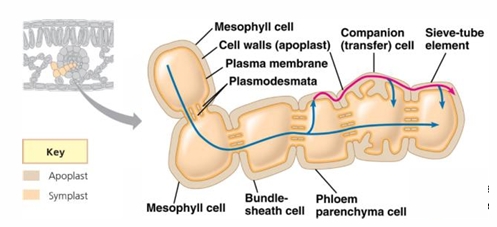
What is needed to transport sugar into phloem cells?
ATP to move the sugar against its concentration gradient
As sugar moves from source to phloem what happens in regards to pressure?
Pressure potential is increasing, and water follows and solute potential is decreasing
As sugar moves down plants to sinks, pressure potential decreases, water leaves, and solute potential is increasing.
In storage roots, where is the sink vs. source?
Sink = leaves
Source = roots
Sugar is moving from roots to leaves
Q4: Which of the following is a correct statement about a difference between xylem and phloem transport?
A. Active transport moves xylem sap but not phloem sap
B. Xylem sap moves from sugar source to sink, but phloem sap does not
C. Transpiration moves phloem sap but not xylem sap
D. Xylem sap moves up; phloem sap moves up or down
D. Xylem sap moves up; phloem sap moves up or down
Is phloem sap movement only one way?
No, it can go up or down depending on the type of plant.
Is xylem movement only one way?
yes, it is only roots to shoots